Impact of Climate Change on Wave Energy Resource in the Mediterranean Coast of Morocco
Abstract
1. Introduction
2. Materials and Methods
2.1. Study Area
2.2. Data Used
2.3. Methods
3. Results for the Present Situation
3.1. Wave Power
3.2. Directional Average Wave Power
3.3. Temporal Variability
4. Climate Change Effects on Wave Power
4.1. Wave Parameters
4.2. Wave Power
4.3. Temporal Variability
5. Summary and Conclusions
Author Contributions
Funding
Acknowledgments
Conflicts of Interest
References
- Kousksou, T.; Allouhi, A.; Belattar, M.; Jamil, A.; El Rhafiki, T.; Arid, A.; Zeraouli, Y. Renewable energy potential and national policy directions for sustainable development in Morocco. Renew. Sustain. Energy Rev. 2015, 47, 46–57. [Google Scholar] [CrossRef]
- Zeroual, A.; Ankrim, M.; Wilkinson, A.J. Stochastic modelling of daily global solar radiation measured in Marrakesh, Morocco. Renew. Energy 1995, 6, 787–793. [Google Scholar] [CrossRef]
- Ouammi, A.; Zejli, D.; Dagdougui, H.; Benchrifa, R. Artificial neural network analysis of Moroccan solar potential. Renew. Sustain Energy Rev. 2012, 16, 4876–4889. [Google Scholar] [CrossRef]
- Nfaoui, H.; Essiarab, H.; Sayigh, A.A.M. A stochastic Markov chain model for simulating wind speed time series at Tangiers, Morocco. Renew. Energy 2004, 29, 1407–1418. [Google Scholar] [CrossRef]
- Ouammi, A.; Sacile, R.; Zejli, D.; Mimet, A.; Benchrifa, R. Sustainability of a wind power plant: Application to different Moroccan sites. Energy 2010, 35, 4226–4236. [Google Scholar] [CrossRef]
- ICEX. Energías Renovables en Marruecos; Technical Report; ICEX, Ministerio de Economía y Competitividad: Madrid, Spain, 2019.
- ICEX. El Mercado de las Energías Renovables en Marruecos; Technical Report; ICEX, Ministerio de Economía y Competitividad: Madrid, Spain, 2014.
- Lenee-Bluhm, P.; Paasch, R.; Özkan-Haller, H.T. Characterizing the wave energy resource of the US Pacific Northwest. Renew. Energy 2011, 36, 2106–2119. [Google Scholar] [CrossRef]
- Franzitta, V.; Catrini, P.; Curto, D. Wave energy assessment along Sicilian coastline, based on DEIM point absorber. Energies 2017, 10, 376. [Google Scholar] [CrossRef]
- Franzitta, V.; Curto, D. Sustainability of the renewable energy extraction close to the Mediterranean Islands. Energies 2017, 10, 283. [Google Scholar] [CrossRef]
- Farkas, A.; Degiuli, N.; Martić, I. Assessment of the offshore wave energy potential in the Croatian part of the Adriatic Sea and comparison with wind energy potential. Energies 2019, 12, 2357. [Google Scholar] [CrossRef]
- Iglesias, G.; Carballo, R. Wave energy potential along the Death Coast (Spain). Energy 2009, 34, 1963–1975. [Google Scholar] [CrossRef]
- Iglesias, G.; Carballo, R. Wave energy resource in the Estaca de Bares area (Spain). Renew. Energy 2010, 35, 1574–1584. [Google Scholar] [CrossRef]
- Iglesias, G.; Carballo, R. Wave power for La Isla Bonita. Energy 2010, 35, 513–521. [Google Scholar] [CrossRef]
- Iglesias, G.; Carballo, R. Wave resource in El Hierro—An island towards energy self-sufficiency. Renew. Energy 2011, 36, 689–698. [Google Scholar] [CrossRef]
- Rusu, E.; Guedes Soares, C. Wave energy pattern around the Madeira Islands. Energy 2012, 45, 771–785. [Google Scholar] [CrossRef]
- Rusu, L.; Guedes Soares, C. Wave energy assessments in the Azores Islands. Renew. Energy 2012, 45, 183–196. [Google Scholar] [CrossRef]
- Sierra, J.P.; González-Marco, D.; Sospedra, J.; Gironella, X.; Mösso, C.; Sánchez-Arcilla, A. Wave energy resource assessment in Lanzarote (Spain). Renew. Energy 2013, 55, 480–489. [Google Scholar] [CrossRef]
- Gonçalves, M.; Martinho, P.; Guedes Soares, C. Assessment of wave energy in the Canary Islands. Renew. Energy 2014, 68, 774–784. [Google Scholar] [CrossRef]
- Mota, P.; Pinto, J.P. Wave energy potential along the western Portuguese coast. Renew. Energy 2014, 71, 8–17. [Google Scholar] [CrossRef]
- Pastor, J.; Dou, Y.Q.; Liu, Y.C. Wave resource energy analysis for use in wave energy conversion. In Proceedings of the Industrial Energy Technology Conference, New Orleans, LA, USA, 20–23 May 2014. [Google Scholar]
- Venugopal, V.; Nemalidinne, R. Wave resource assessment for Scottish waters using a large scale North Atlantic spectral wave model. Renew. Energy 2015, 76, 503–525. [Google Scholar] [CrossRef]
- Guillou, N. Evaluation of wave energy potential in the Sea of Iroise with two spectral models. Ocean. Eng. 2015, 106, 141–151. [Google Scholar] [CrossRef]
- Sierra, J.P.; Martín, C.; Mösso, C.; Mestres, M.; Jebbad, R. Wave energy potential along the Atlantic coast de Morocco. Renew. Energy 2016, 96, 20–32. [Google Scholar] [CrossRef]
- Pastor, J.; Liu, Y. Wave climate resource analysis based on a revised gamma spectrum for wave energy conversion technology. Sustainability 2016, 8, 1321. [Google Scholar] [CrossRef]
- Sierra, J.P.; White, A.; Mösso, C.; Mestres, M. Assessment of the intra-annual and inter-annual variability of the wave energy resource in the Bay of Biscay (France). Energy 2017, 141, 853–868. [Google Scholar] [CrossRef]
- López, M.; Veigas, M.; Iglesias, G. On the wave energy resource of Peru. Energy Convers. Manag. 2015, 90, 34–40. [Google Scholar] [CrossRef]
- Mediavilla, D.G.; Sepúlveda, H.H. Nearshore assessment of wave energy resources in central Chile (2009–2010). Renew. Energy 2016, 90, 136–144. [Google Scholar] [CrossRef]
- Morim, J.; Cartwright, N.; Etemad-Shahidi, A.; Strauss, D.; Hemer, M. Wave energy resource assessment along the southeast coast of Australia on the basis of a 31-year hindcast. Appl. Energy 2016, 184, 276–297. [Google Scholar] [CrossRef]
- Hemer, M.A.; Zieger, S.; Durrant, T.; O’Grady, J.; Hoeke, R.K.; McInnes, K.L.; Rosebrock, U. A revised assessment of Australia’s national wave energy resource. Renew. Energy 2017, 114, 85–107. [Google Scholar] [CrossRef]
- Lucero, F.; Catalán, P.A.; Ossandón, Á.; Beyá, J.; Puelma, A.; Zamorano, L. Wave energy assessment in the central-south coast of Chile. Renew. Energy 2017, 114, 120–131. [Google Scholar] [CrossRef]
- Quitoras, M.R.D.; Abundo, M.L.S.; Danao, L.A.M. A techno-economic assessment of wave energy resources in the Philippines. Renew. Sustain. Energy Rev. 2018, 88, 68–81. [Google Scholar] [CrossRef]
- Liberti, L.; Carillo, A.; Sannino, G. Wave energy resource assessment in the Mediterranean, the Italian perspective. Renew. Energy 2013, 50, 938–949. [Google Scholar] [CrossRef]
- Vicinanza, D.; Cappietti, L.; Ferrante, V.; Contestabile, P. Estimation of the wave energy in the Italian offshore. J. Coast. Res. 2011, 64, 613–617. [Google Scholar]
- Vicinanza, D.; Contestabile, P.; Ferrante, V. Wave energy potential in the north-west of Sardinia (Italy). Renew. Energy 2013, 50, 506–521. [Google Scholar] [CrossRef]
- Bozzi, S.; Archetti, R.; Passoni, G. Wave electricity production in Italian offshore: A preliminary investigation. Renew. Energy 2014, 62, 407–416. [Google Scholar] [CrossRef]
- Sierra, J.P.; Mösso, C.; González-Marco, D. Wave energy resource assessment in Menorca (Spain). Renew. Energy 2014, 71, 51–60. [Google Scholar] [CrossRef]
- Arena, F.; Laface, V.; Malara, G.; Romolo, A.; Viviano, A.; Fiamma, V.; Sannino, G.; Carillo, A. Wave climate analysis for the design of wave energy harvesters in the Mediterranean Sea. Renew. Energy 2015, 77, 125–141. [Google Scholar] [CrossRef]
- Iuppa, C.; Cavallaro, L.; Vicinanza, D.; Foti, E. Investigation of suitable sites for Wave Energy Converters around Sicily (Italy). Ocean Sci. 2015, 12, 543–557. [Google Scholar] [CrossRef]
- Monteforte, M.; Re, C.L.; Ferreri, G.B. Wave energy assessment in Sicily (Italy). Renew. Energy 2015, 78, 276–287. [Google Scholar] [CrossRef]
- Besio, G.; Mentaschi, L.; Mazzino, A. Wave energy resource assessment in the Mediterranean Sea on the basis of a 35-year hindcast. Energy 2016, 94, 50–63. [Google Scholar] [CrossRef]
- Vannucchi, V.; Cappietti, L. Wave energy assessment and performance estimation of state of the art wave energy converters in Italian hotspots. Sustainability 2016, 8, 1300. [Google Scholar] [CrossRef]
- Franzitta, V.; Curto, D.; Milone, D.; Rao, D. Assessment of renewable sources for the energy consumption in Malta in the Mediterranean Sea. Energies 2016, 9, 1034. [Google Scholar] [CrossRef]
- Lavidas, G.; Venugopal, V. Wave energy resource evaluation and characterization for the Libyan Sea. Int. J. Mar. Energy 2017, 18, 1–14. [Google Scholar] [CrossRef]
- Lavidas, G.; Venugopal, V. A 35 year high-resolution wave atlas for nearshore energy production and economics at the Aegean Sea. Renew. Energy 2017, 103, 401–417. [Google Scholar] [CrossRef]
- Soukissian, T.; Denaxa, D.; Karathanasi, F.; Prospathopoulos, A.; Sarantakos, K.; Iona, A.; Georgantas, K.; Mavrakos, S. Marine Renewable Energy in the Mediterranean Sea: Status and Perspectives. Energies 2017, 10, 1512. [Google Scholar] [CrossRef]
- Lavidas, G.; Venugopal, V. Energy Production Benefits by Wind and Wave Energies for the Autonomous System of Crete. Energies 2018, 11, 2741. [Google Scholar] [CrossRef]
- Reeve, D.E.; Chen, Y.; Pan, S.; Magar, V.; Simmonds, D.J.; Zacharioudaki, A. An investigation of the impacts of climate change on wave energy generation: The Wave Hub, Cornwall, UK. Renew. Energy 2011, 36, 2404–2413. [Google Scholar] [CrossRef]
- Young, I.; Zieger, S.; Babanin, A.V. Global trends in wind speed and wave height. Science 2011, 332, 451–455. [Google Scholar] [CrossRef] [PubMed]
- Zheng, C.W.; Li, C.Y. Variation of the wave energy and significant wave height in the China Sea and adjacent waters. Renew. Sustain. Energy Rev. 2015, 43, 381–387. [Google Scholar] [CrossRef]
- Ulazia, A.; Penalba, M.; Ibarra-Berastegi, G.; Saenz, J. Wave energy trends over the Bay of Biscay and the consequences for wave energy converters. Energy 2017, 141, 624–634. [Google Scholar] [CrossRef]
- Zheng, C.W.; Wang, Q.; Li, C.Y. An overview of medium- to long-term predictions of global wave energy resources. Renew. Sustain. Energy Rev. 2017, 79, 1492–1502. [Google Scholar] [CrossRef]
- Ulazia, A.; Penalba, M.; Rabanal, A.; Ibarra-Berastegi, G.; Ringwood, J.; Saenz, J. Historical evolution of the wave resource and energy production off the Chilean Coast over the 20th Century. Energies 2018, 11, 2289. [Google Scholar] [CrossRef]
- Gonçalves, M.; Martinho, P.; Guedes Soares, C. A 33-year hindcast on wave energy assessment in the western French coast. Energy 2018, 165, 790–801. [Google Scholar] [CrossRef]
- Penalba, M.; Ulazia, A.; Saenz, J.; Ringwood, J. Impact of long-term resource variations on wave energy Farms: The Icelandic case. Energy 2020, 192, 116609. [Google Scholar] [CrossRef]
- Harrison, G.P.; Wallace, A.R. Sensitivity of wave energy to climate change. IEEE Trans. Energy Convers. 2005, 20, 870–877. [Google Scholar] [CrossRef]
- Mackay, E.B.L.; Bahaj, A.S.; Chellenor, P.G. Uncertainty in wave energy resource assessment. Part 1: Historic data. Renew. Energy 2010, 35, 1792–1808. [Google Scholar] [CrossRef]
- Mackay, E.B.L.; Bahaj, A.S.; Chellenor, P.G. Uncertainty in wave energy resource assessment. Part 2: Variability and predictability. Renew. Energy 2010, 35, 1809–1819. [Google Scholar] [CrossRef]
- Sierra, J.P.; Casas-Prat, M.; Campins, E. Impact of climate change on wave energy resource: The case of Menorca (Spain). Renew. Energy 2017, 101, 275–285. [Google Scholar] [CrossRef]
- Saprykina, Y.; Kuznetsov, S. Analysis of the variability of wave energy due to climate changes on the example of the Black Sea. Energies 2018, 11, 2020. [Google Scholar] [CrossRef]
- Church, J.A.; Clark, P.U.; Cazenave, A.; Gregory, J.M.; Jevrejeva, S.; Levermann, A.; Merrifield, M.A.; Milne, G.A.; Nerem, R.S. Sea level change. In Climate Change 2013: The Physical Science Basis; Contribution of Working Group I to the Fifth Assessment Report of the Intergovernmental Panel on Climate Change; Stocker, T.F., Qin, D., Plattner, G.-K., Tignor, M., Allen, S.K., Boschung, J., Nauels, A., Xia, Y., Bex, V., Midgley, P.M., Eds.; Cambridge University Press: Cambridge, UK; New York, NY, USA, 2013. [Google Scholar]
- Ulbrich, U.; Leckebusch, G.C.; Pinto, J.G. Extra-tropical cyclones in the present and future climate: A review. Theor. Appl. Climatol. 2009, 96, 117–131. [Google Scholar] [CrossRef]
- Bengtsson, L.; Hodges, K.I.; Keenlyside, N. Will extratropical storms intensify in a warmer climate? J. Clim. 2009, 22, 2276–2301. [Google Scholar] [CrossRef]
- Maheras, P.; Flocas, H.A.; Patrikas, I.; Anagnostopoulou, C.A. 40 year objective climatology of surface ciclones in the Mediterranean region: Spatial and temporal distribution. Int. J. Climatol. 2001, 21, 109–130. [Google Scholar] [CrossRef]
- Campins, J.; Genovés, A.; Picornell, M.A.; Jansà, A. Climatology of Mediterranean cyclones using the ERA-40 dataset. Int. J. Climatol. 2011, 31, 1596–1614. [Google Scholar] [CrossRef]
- Lionello, P.; Dalan, F.; Elvini, E. Cyclones in the Mediterranean region: The present and the doubled CO2 climate scenarios. Clim. Res. 2002, 22, 147–159. [Google Scholar] [CrossRef]
- Campins, J.; Jansà, A.; Genovés, A. Three-dimensional structure of western Mediterranean cyclones. Int. J. Climatol. 2006, 26, 323–343. [Google Scholar] [CrossRef]
- Lionello, P.; Bhend, J.; Buzzi, A.; Della-Marta, P.; Krichak, S.; Jansa, A.; Maheras, P.; Sanna, A.; Trigo, I.; Trigo, R. Cyclones in the Mediterranean region: Climatology and effects on the environment. In Mediterranean Climate Variability; Lionello, P., Malanotte-Rizzoli, P., Boscolo, R., Eds.; Elsevier Science: Amsterdam, The Netherlands, 2006; pp. 325–372. [Google Scholar]
- Raji, O.; Dezileau, L.; Von Grafenstein, U.; Niazi, S.; Snoussi, M.; Martinez, P. Extreme seas events during the last millennium in the northeast of Morocco. Nat. Hazards Earth Syst. Sci. 2015, 15, 203–211. [Google Scholar] [CrossRef]
- El Mrini, A.; Anthony, E.J.; Maanan, M.; Taaouati, M.; Nachite, D. Beach-dune degradation in a Mediterranean context of strong development pressures, and the missing integrated management perspective. Ocean Coast. Manag. 2012, 69, 299–306. [Google Scholar] [CrossRef]
- Anfuso, G.; Martinez del Pozo, A.; Nachite, D.; Benavente, J.; Macias, A. Morphological characteristics and medium-term evolution of the beaches between Ceuta and Cabo Negro (Morocco). Environ. Geol. 2007, 52, 933–946. [Google Scholar] [CrossRef]
- Raji, O.; Niazi, S.; Snoussi, M.; Dezileau, L.; Khouakhi, A. Vulnerability assessment of a lagoon to sea level rise and stor events: Nador lagoon (NE Morocco). J. Coast. Res. 2013, 65, 802–807. [Google Scholar] [CrossRef]
- Casas-Prat, M.; Sierra, J.P. Projected future wave climate in the NW Mediterranean Sea. J. Geophys. Res. Oceans 2013, 118, 3548–3568. [Google Scholar] [CrossRef]
- Lionello, P.; Boldrin, U.; Giorgi, F. Future changes in cyclone climatology over Europe as inferred from a regional climate simulation. Clim. Dyn. 2008, 30, 657–671. [Google Scholar] [CrossRef]
- Donat, M.G.; Leckebusch, G.C.; Wild, S.; Ulbrich, U. Future changes in European winter storm losses and extreme wind speeds inferred from GCM and RCM multi-model simulations. Nat. Hazards Earth Syst. Sci. 2011, 11, 1351–1370. [Google Scholar] [CrossRef]
- Pinto, J.G.; Ulbrich, U.; Leckebusch, G.C.; Spangehl, T.; Zacharias, S. Changes in storm track and cyclone activity in three SRES ensemble experiments with the ECHAM5/MPI-OM1 GCM. Clim. Dyn. 2009, 29, 195–210. [Google Scholar] [CrossRef]
- Mori, N.; Yasuda, T.; Mase, H.; Tom, T.; Oku, Y. Projection of extreme wave climate change under global warming. Hydrol. Res. Lett. 2010, 4, 15–19. [Google Scholar] [CrossRef]
- Dobrynin, M.; Murawsky, J.; Yang, S. Evolution of the global wind wave climate in CMIP5 experiments. Geophys. Res. Lett. 2012, 39, 1–6. [Google Scholar] [CrossRef]
- Fan, Y.; Lin, S.J.; Held, I.M.; Yu, Z.; Tolman, H.L. Global ocean surface wave simulation using a coupled atmospheric-wave model. J. Clim. 2012, 26, 6233–8288. [Google Scholar] [CrossRef]
- Semedo, A.; Weisse, R.; Behrens, A.; Sterl, A.; Bengtsson, L.; Gunther, H. Projection of global wave climate change toward the end of the twenty-first century. Bull. Am. Meterol. Soc. 2013, 26, 8269–8288. [Google Scholar] [CrossRef]
- Hemer, M.A.; Fan, Y.; Mori, N.; Semedo, A.; Wang, X.L. Projected change in wave climate from a multi-model ensemble. Nat. Clim. Chang. 2013, 3, 471–476. [Google Scholar] [CrossRef]
- Wang, X.L.; Feng, Y.; Swail, V.R. Changes in global ocean wave heights as projected using multimodel CMIP5 simulations. Geophys. Res. Lett. 2014, 41, 1026–1034. [Google Scholar] [CrossRef]
- Hemer, M.A.; Trenham, C. Evaluation of a CMIP5 derived dynamical global wind wave climate model ensemble. Ocean Model. 2016, 103, 190–223. [Google Scholar] [CrossRef]
- Casas-Prat, M.; Wang, X.L.; Swart, N. CMIP5-based global wave climate projections including the entire Artic Ocean. Ocean Model. 2018, 123, 66–85. [Google Scholar] [CrossRef]
- Lionello, P.; Cogo, S.; Galati, M.B.; Sanna, A. The Mediterranean surface wave climate inferred from future scenario simulation. Glob. Planet. Chang. 2008, 63, 152–162. [Google Scholar] [CrossRef]
- Hemer, M.A.; McInnes, K.L.; Ranasinghe, R. Climate and variability bias adjustment of climate model-derived winds for a southeast Australian dynamical wave model. Ocean Dyn. 2012, 62, 87–104. [Google Scholar] [CrossRef]
- Grabemann, I.; Weisse, R. Climate change impact on extreme wave conditions in the North Sea: An ensemble study. Ocean Dyn. 2008, 58, 199–212. [Google Scholar] [CrossRef]
- Giorgi, F.; Lionello, P. Climate change projections for the Mediterranean region. Glob. Planet. Chang. 2008, 63, 90–104. [Google Scholar] [CrossRef]
- Charles, E.; Idier, D.; Delecluse, P.; Déqué, M.; Cozannet, G. Climate change impact on waves in the Bay of Biscay, France. Ocean Dyn. 2012, 62, 831–848. [Google Scholar] [CrossRef]
- Ruti, P.M.; Somot, S.; Giorgi, F.; Dubois, C.; Flaounas, E.; Obermann, A.; Dell’Aquila, A.; Pisacane, G.; Harzallah, A.; Lombardi, E.; et al. Med-Cordex initiative for Mediterranean climate studies. Bull. Am. Meteorol. Soc. 2016, 97, 1187–1208. [Google Scholar] [CrossRef]
- Moss, R.H.; Edmonds, J.A.; Hibbard, K.A.; Manning, M.R.; Rose, S.K.; van Vuuren, D.P.; Carter, T.R.; Emori, S.; Kainuma, M.; Kram, T.; et al. The next generation of scenarios for climate change research and assessment. Nature 2010, 463, 747–756. [Google Scholar] [CrossRef] [PubMed]
- Cornett, A.M. A global wave energy resource assessment. In Proceedings of the International Offshore and Polar Engineering Conference, Vancouver, BC, Canada, 6–11 July 2008; pp. 318–326. [Google Scholar]
- Carballo, R.; Sanchez, M.; Ramos, V.; Fraguela, J.A.; Iglesias, G. Intra-annual wave resource characterization for energy exploitation: A new decision-aid tool. Energy Convers. Manag. 2015, 93, 1–8. [Google Scholar] [CrossRef]

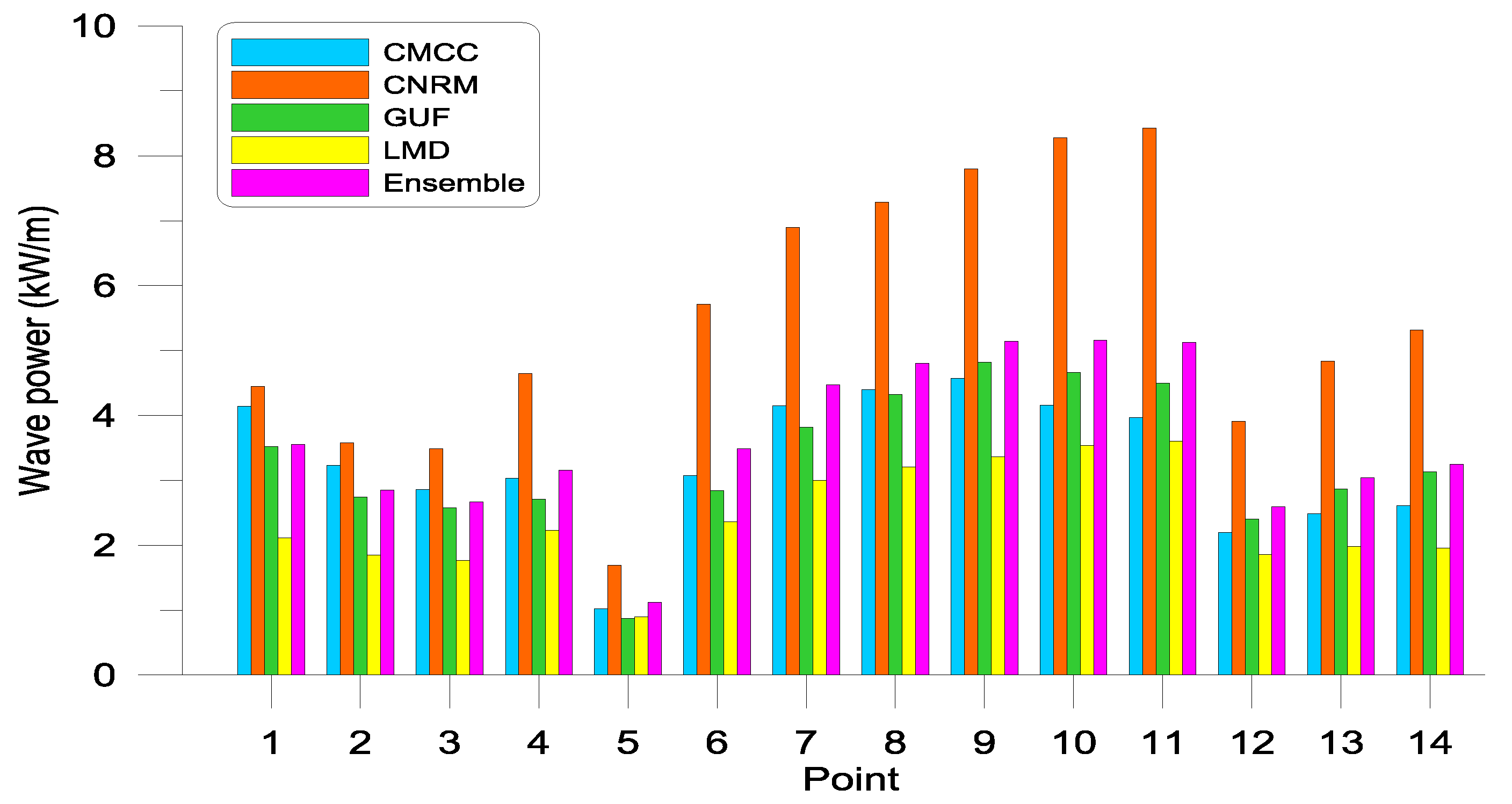
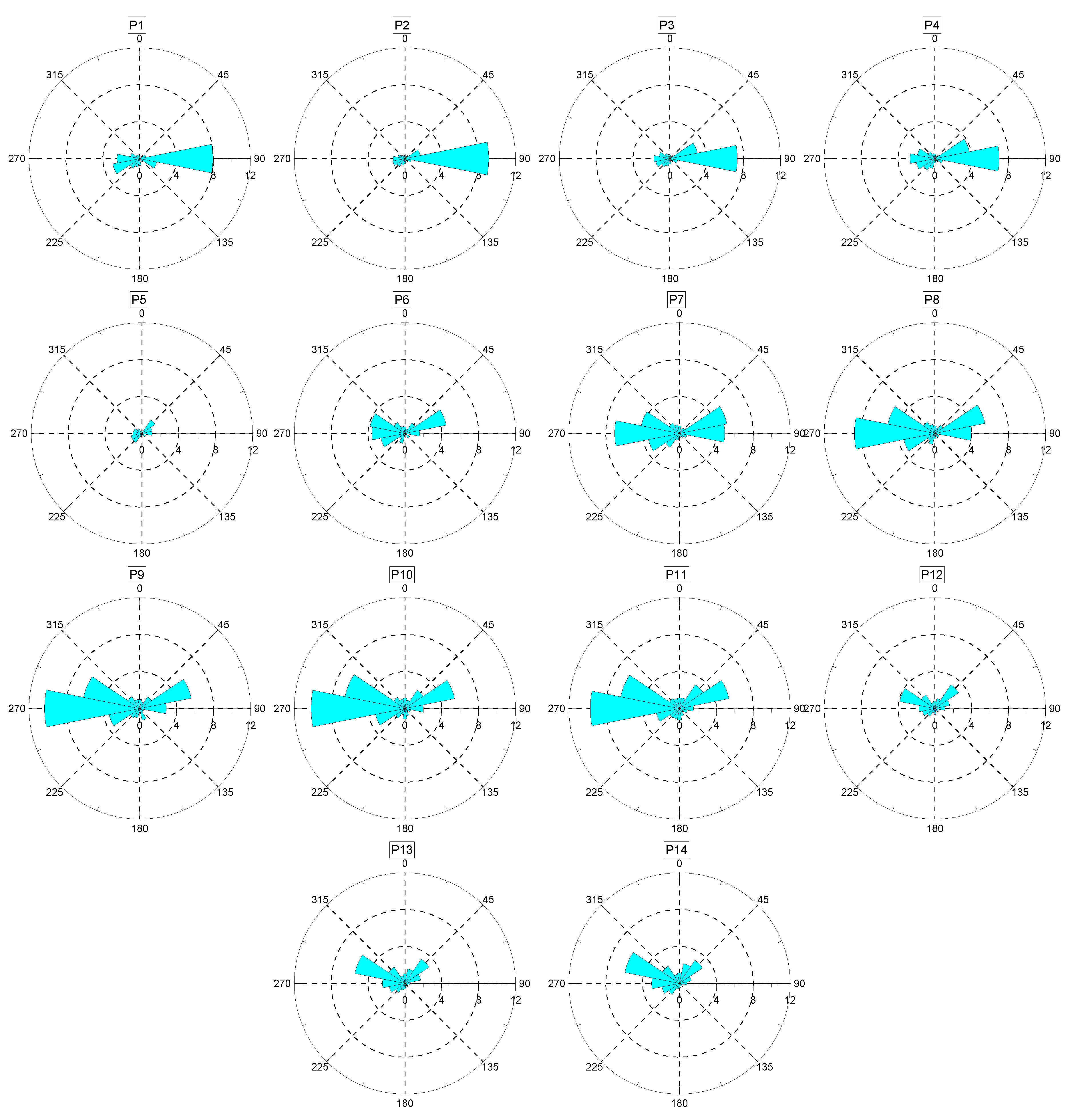
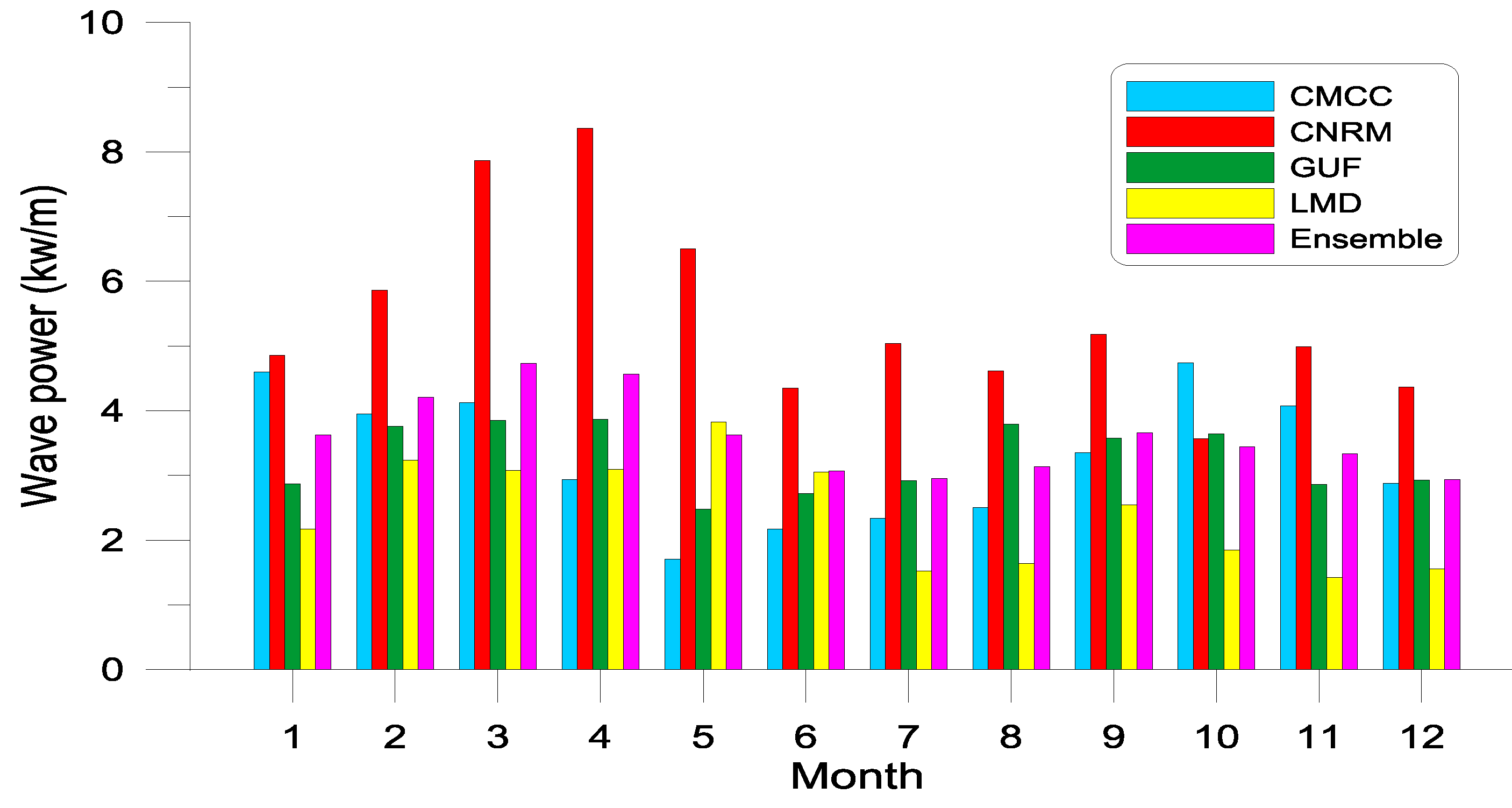
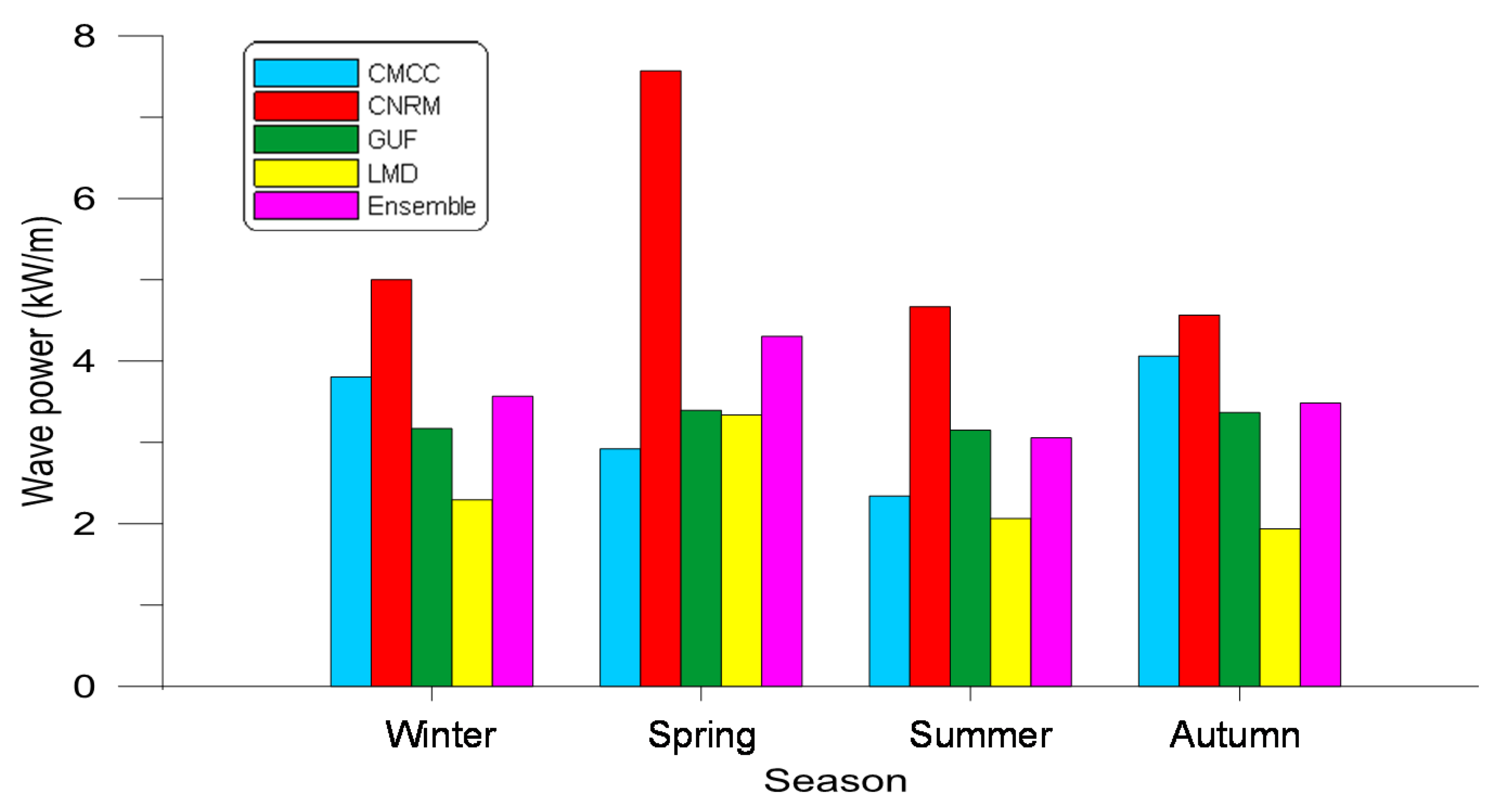
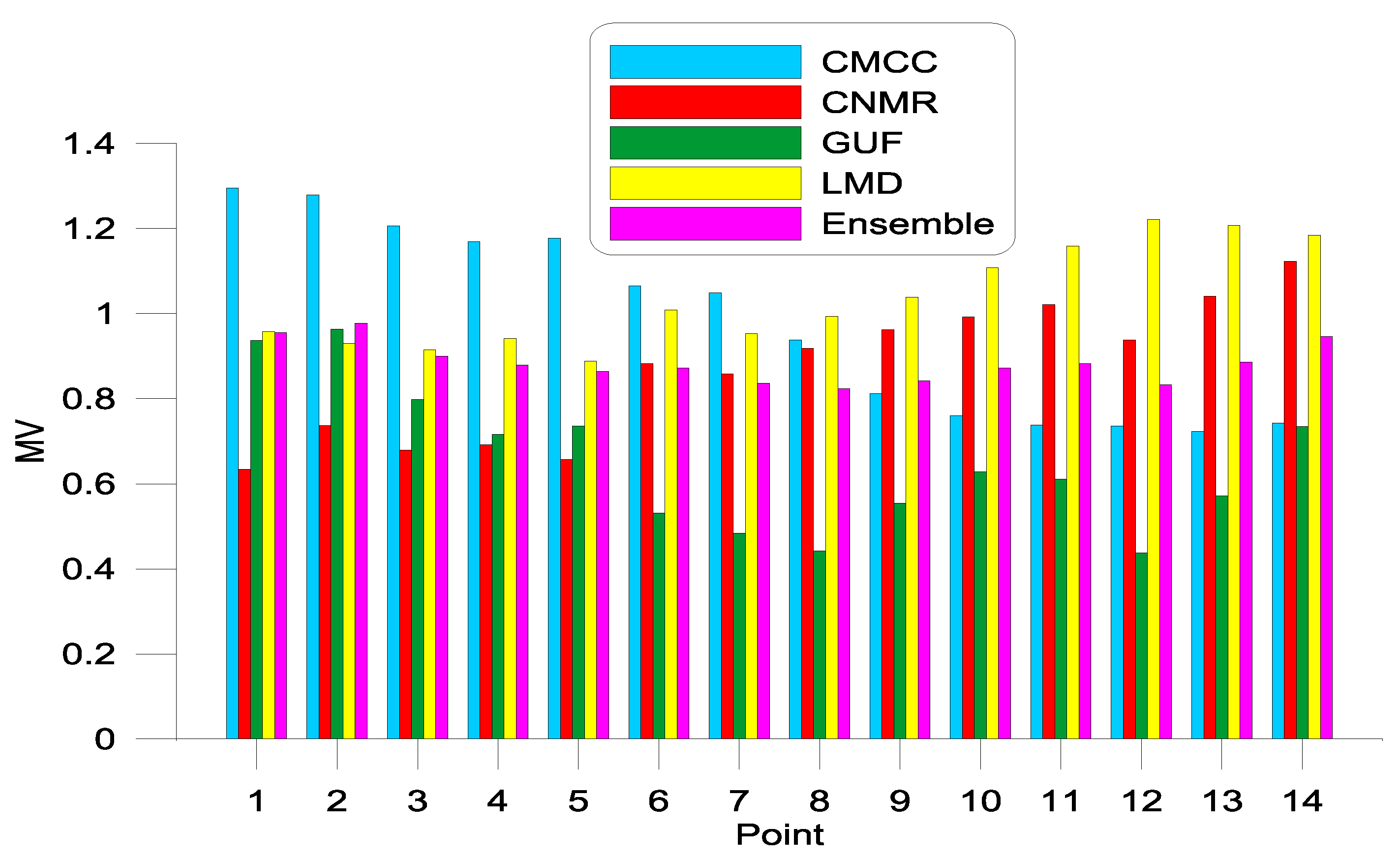


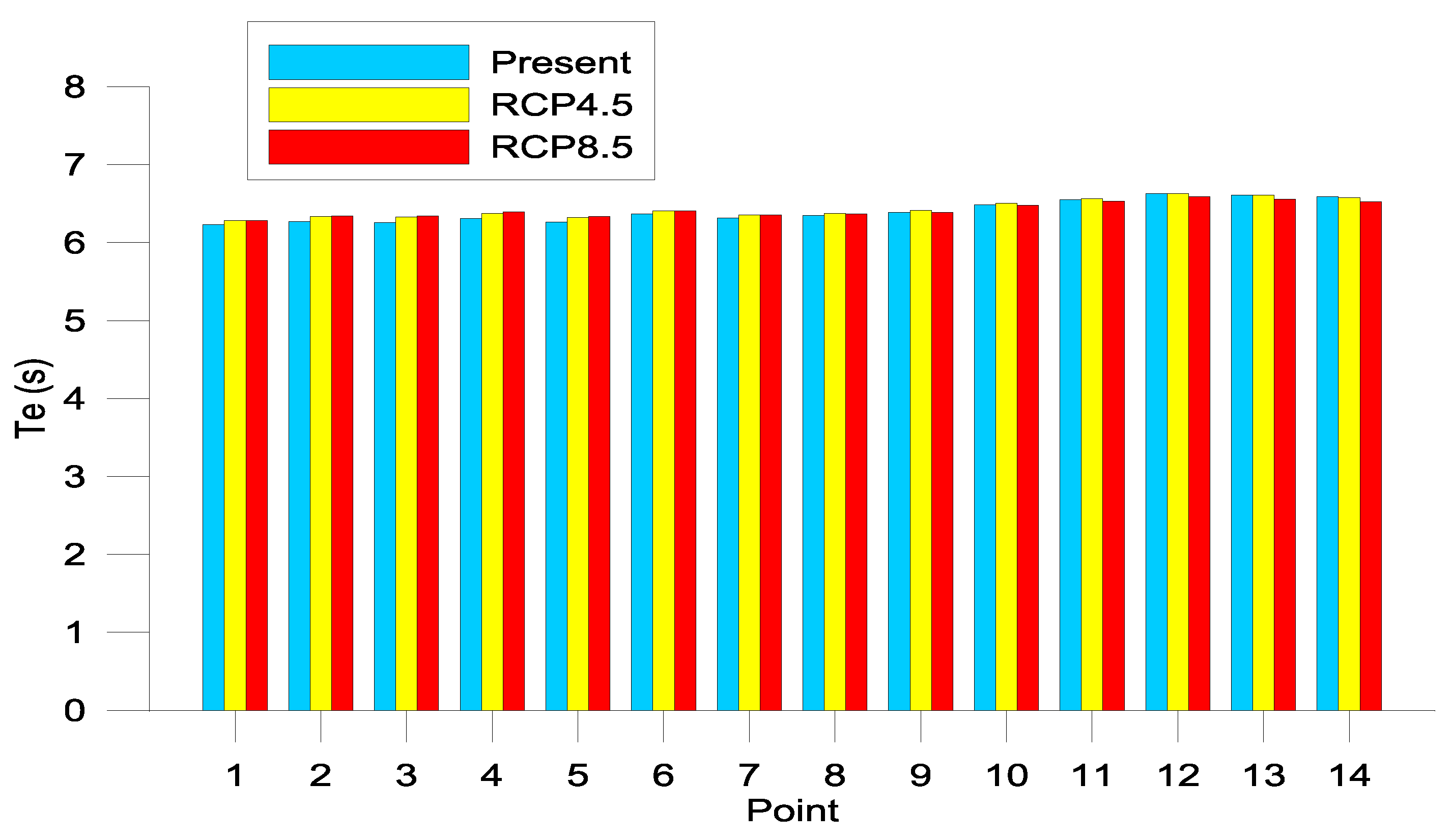
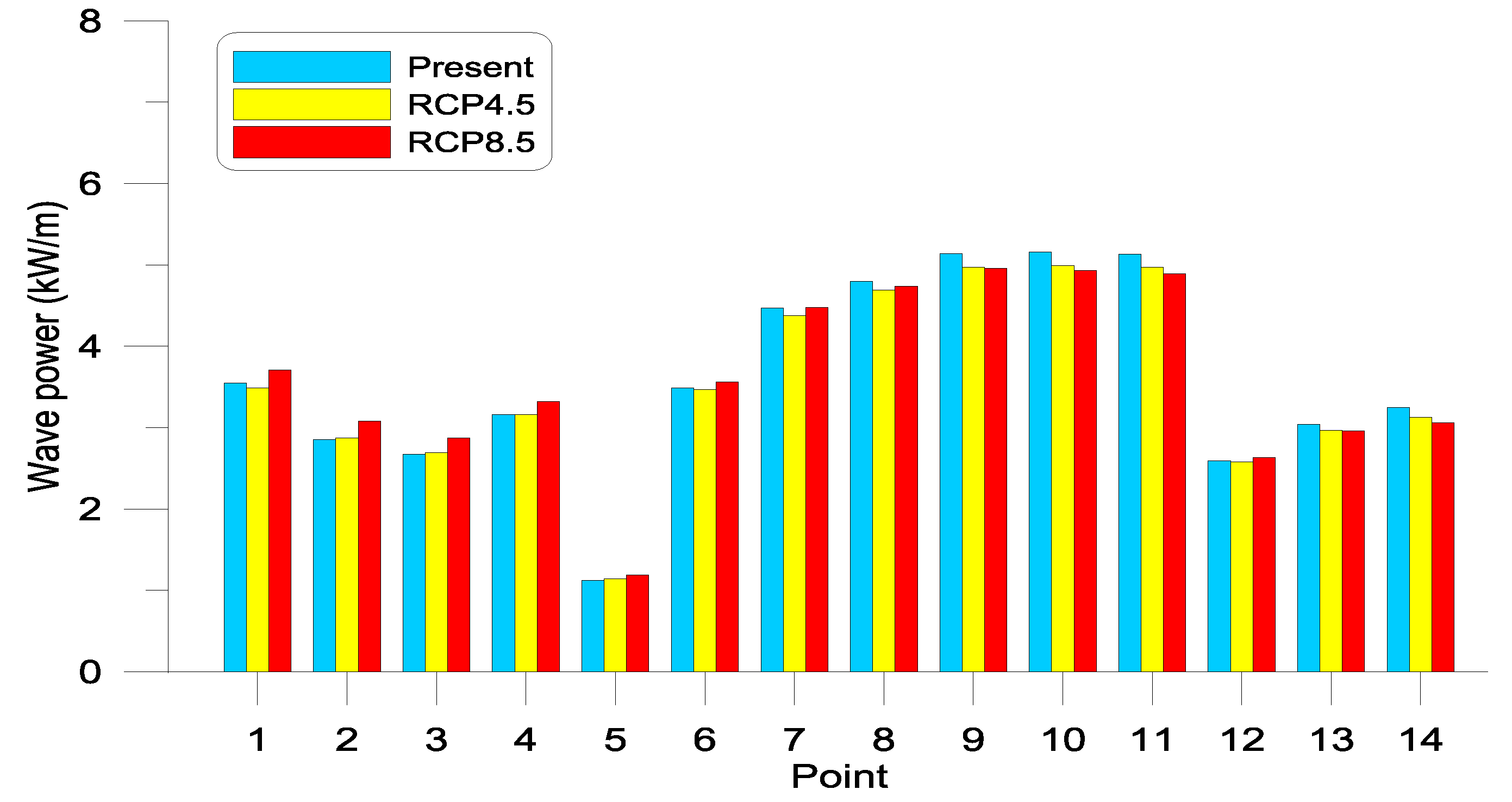
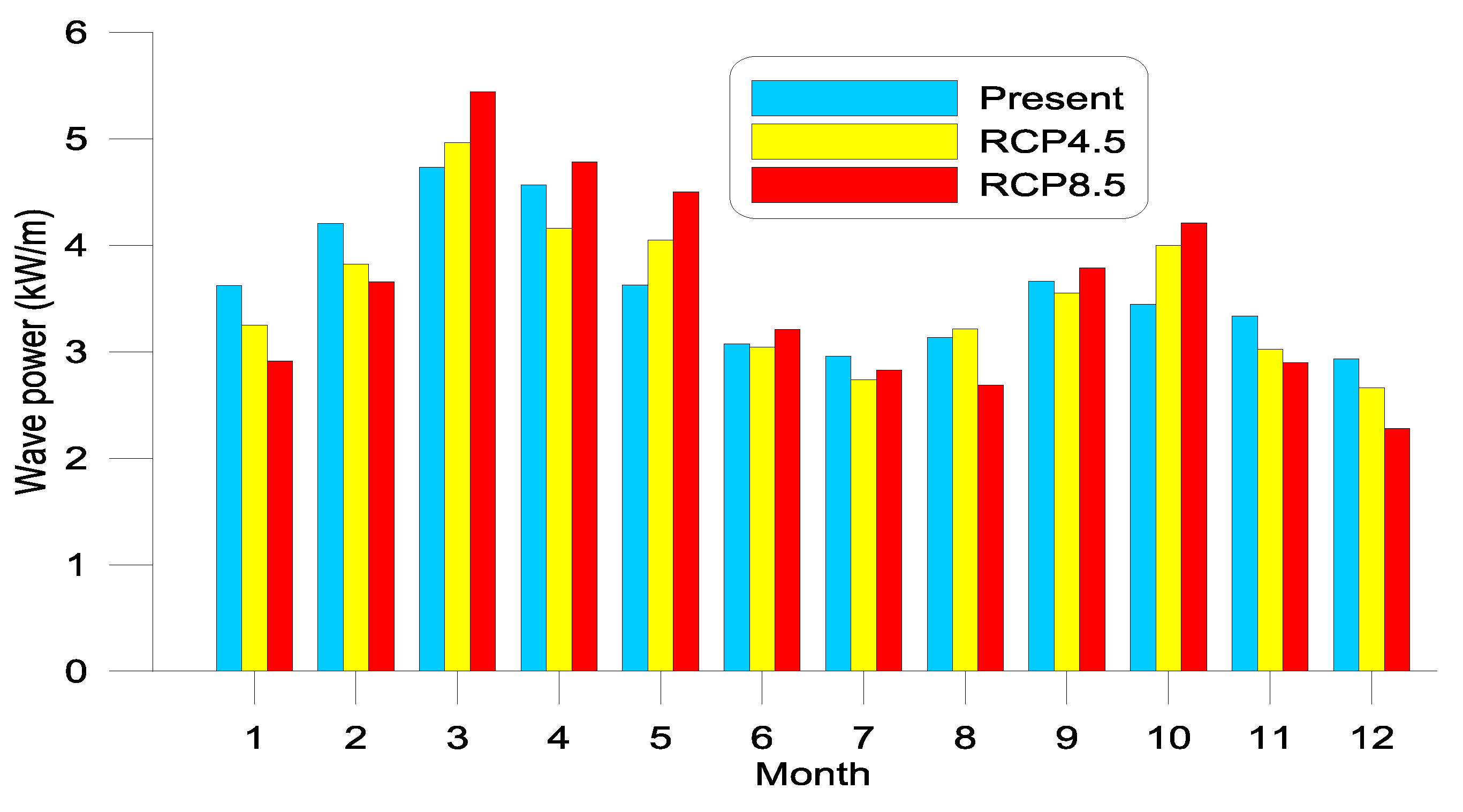


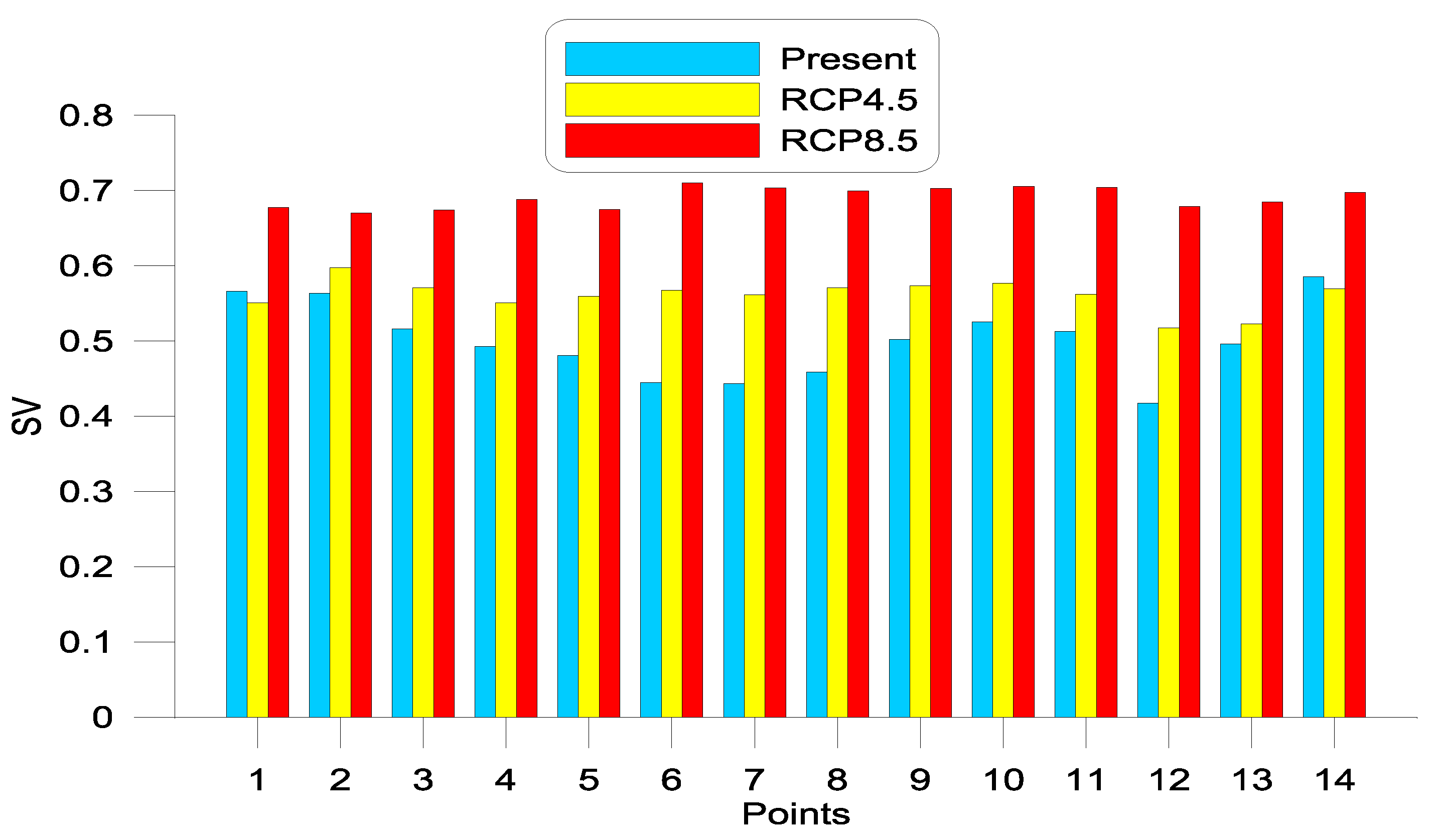
| Point | Longitude (W) | Longitude (N) | Depth (m) | Distance (km) |
|---|---|---|---|---|
| P1 | 5°15′ | 36°00′ | 830 | 11 |
| P2 | 5°15′ | 35°45′ | 180 | 7.5 |
| P3 | 5°00′ | 35°30′ | 200 | 9.5 |
| P4 | 4°45′ | 35°30′ | 420 | 25 |
| P5 | 4°30′ | 35°15′ | 150 | 8 |
| P6 | 4°15′ | 35°15′ | 240 | 7 |
| P7 | 4°00′ | 35°30′ | 290 | 27 |
| P8 | 3°45′ | 35°30′ | 320 | 24 |
| P9 | 3°30′ | 35°30′ | 700 | 29 |
| P10 | 3°15′ | 35°30′ | 600 | 24.5 |
| P11 | 3°00′ | 35°30′ | 200 | 7 |
| P12 | 2°45′ | 35°15′ | 100 | 10 |
| P13 | 2°30′ | 35°15′ | 120 | 13 |
| P14 | 2°15′ | 35°15′ | 140 | 15.5 |
| Point | Present (kW/m) | RCP4.5 (kW/m) | RCP4.5 Variation (%) | RCP8.5 (kW/m) | RCP8.5 Variation (%) |
|---|---|---|---|---|---|
| P1 | 3.56 | 3.50 | −1.7 | 3.71 | 4.3 |
| P2 | 2.85 | 2.87 | 0.8 | 3.08 | 7.9 |
| P3 | 2.68 | 2.70 | 0.8 | 2.87 | 7.2 |
| P4 | 3.16 | 3.17 | 0.4 | 3.32 | 5.3 |
| P5 | 1.12 | 1.14 | 2.0 | 1.20 | 6.7 |
| P6 | 3.50 | 3.47 | −0.7 | 3.57 | 2.0 |
| P7 | 4.47 | 4.39 | −1.8 | 4.48 | 0.3 |
| P8 | 4.81 | 4.69 | −2.3 | 4.75 | −1.3 |
| P9 | 5.14 | 4.98 | −3.2 | 4.96 | −3.4 |
| P10 | 5.16 | 4.99 | −3.3 | 4.93 | −4.5 |
| P11 | 5.13 | 4.97 | −3.1 | 4.89 | −4.6 |
| P12 | 2.59 | 2.58 | −0.4 | 2.63 | 1.5 |
| P13 | 3.05 | 2.97 | −2.4 | 2.96 | −2.9 |
| P14 | 3.26 | 3.13 | −3.9 | 3.06 | −6.1 |
| Average | 3.60 | 3.54 | −1.8 | 3.59 | −0.1 |
| Month | Present (kW/m) | RCP4.5 (kW/m) | RCP4.5 Variation (%) | RCP8.5 (kW/m) | RCP8.5 Variation (%) |
|---|---|---|---|---|---|
| January | 3.62 | 3.25 | −10.3 | 2.91 | −19.6 |
| February | 4.20 | 3.83 | −9.0 | 3.66 | −13.0 |
| March | 4.73 | 4.96 | 4.9 | 5.44 | 15.0 |
| April | 4.56 | 4.16 | −8.9 | 4.78 | 4.7 |
| May | 3.63 | 4.05 | 11.6 | 4.50 | 24.0 |
| June | 3.07 | 3.04 | −1.0 | 3.21 | 4.5 |
| July | 2.96 | 2.74 | −7.3 | 2.83 | −4.3 |
| August | 3.14 | 3.22 | 2.5 | 2.69 | −14.3 |
| September | 3.66 | 3.55 | −3.0 | 3.79 | 3.4 |
| October | 3.45 | 4.00 | 16.0 | 4.21 | 22.1 |
| November | 3.34 | 3.02 | −9.4 | 2.90 | −13.1 |
| December | 2.93 | 2.66 | −9.3 | 2.28 | −22.3 |
| Season | Present (kW/m) | RCP4.5 (kW/m) | RCP4.5 Variation (%) | RCP8.5 (kW/m) | RCP8.5 Variation (%) |
|---|---|---|---|---|---|
| Winter | 3.57 | 3.23 | −9.6 | 2.93 | −18.0 |
| Spring | 4.31 | 4.39 | 2.0 | 4.91 | 14.0 |
| Summer | 3.06 | 3.00 | −1.8 | 2.91 | −4.9 |
| Autumn | 3.48 | 3.53 | 1.4 | 3.64 | 4.5 |
© 2020 by the authors. Licensee MDPI, Basel, Switzerland. This article is an open access article distributed under the terms and conditions of the Creative Commons Attribution (CC BY) license (http://creativecommons.org/licenses/by/4.0/).
Share and Cite
Sierra, J.P.; Castrillo, R.; Mestres, M.; Mösso, C.; Lionello, P.; Marzo, L. Impact of Climate Change on Wave Energy Resource in the Mediterranean Coast of Morocco. Energies 2020, 13, 2993. https://doi.org/10.3390/en13112993
Sierra JP, Castrillo R, Mestres M, Mösso C, Lionello P, Marzo L. Impact of Climate Change on Wave Energy Resource in the Mediterranean Coast of Morocco. Energies. 2020; 13(11):2993. https://doi.org/10.3390/en13112993
Chicago/Turabian StyleSierra, Joan Pau, Ricard Castrillo, Marc Mestres, César Mösso, Piero Lionello, and Luigi Marzo. 2020. "Impact of Climate Change on Wave Energy Resource in the Mediterranean Coast of Morocco" Energies 13, no. 11: 2993. https://doi.org/10.3390/en13112993
APA StyleSierra, J. P., Castrillo, R., Mestres, M., Mösso, C., Lionello, P., & Marzo, L. (2020). Impact of Climate Change on Wave Energy Resource in the Mediterranean Coast of Morocco. Energies, 13(11), 2993. https://doi.org/10.3390/en13112993






